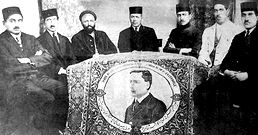An American Martyr in Iran
7.8.2012
Somewhere in the Armenian cemetery of the city of Tabriz, a young American called Howard Baskerville was buried 102 years ago. The ravages of time have totally obliterated his tombstone, leaving no evidence of where he was buried. Only an old photograph of the grave has survived that indicates what it once looked like. But the memory of his heroic sacrifice for the freedom of the people of Iran will never be erased from the history of this country.
The story of this young man goes back to the turbulent days of the spring of 1909 in Tabriz, when the city was besieged by the government forces and ravaged by famine and starvation. The previous year the autocratic shah, supported by the Russian Cossack brigade, had bombarded the Parliament building in an attempt to suppress the fledgling constitutional government, but almost at once the citizens of Tabriz refused to accept this reintroduction of absolute rule. Their rebellion was sustained for several months until the spring of 1909 when the pro-shah government army had effectively blockaded Tabriz and reduced its inhabitants to dire straits.
It was at this point that the young Baskerville became involved in the drama. He had graduated from Princeton University two years earlier and joined the American Presbyterian Mission in Tabriz as a teacher. He had been accepted to teach science subjects and English at the Mission’s Memorial school, but shortly after his arrival found himself in a city virtually under siege by the Royalist army. In the rapidly deteriorating situation, his sympathies lay entirely with its starving inhabitants and it was not long before he joined the anti-government forces.
With his military training, Baskerville helped to mobilize and train a sizeable force of volunteers, and then on his own initiative, made a brave but perhaps rash attempt to break the blockade by launching a sortie against a district of the town where the Royalist forces had food stores. Leading from the front, he was killed almost at once, dying a martyr’s death for the sake of liberty and freedom. The following day he was buried in the Armenian cemetery, a huge procession of the inhabitants of the beleaguered town accompanying his body to the graveyard.
The rarely-seen photographs in this multimedia report, show scenes from Tabriz and of the nationalist fighters against the autocratic rule of Mohammad Ali Shah Qajar.
This multimedia report was first published in April 2011.


